Foundations and Trends R
Machine Learning
Vol. 5, No. 4 (2012) 287–364
c 2013 B. Kulis
DOI: 10.1561/2200000019
in
Metric Learning: A Survey
By Brian Kulis
Contents
1 Introduction
2 Distance Learning via Linear Transformations
2.1 A Simple Motivating Example
2.2 Basic Techniques and Notation
2.3 Regularized Transformation Learning
2.4 Representative Special Cases
2.5 Optimization Techniques
2.6 Summary
3 Nonlinear Models for Metric Learning
3.1 Kernelization of Linear Methods
3.2 Other Nonlinear Methods
4 Extensions
4.1 Metric Learning for Kernel Regression
4.2 Metric Learning for Ranking
4.3 Dimensionality Reduction and Data Visualization
4.4 Database Indexing
4.5 Domain Adaptation
288
292
292
293
295
300
310
320
321
322
333
339
339
340
341
342
343
�
5 Applications
5.1 Computer Vision
5.2 Text Analysis
5.3 Other Applications
6 Conclusions
A Representer Theorem Proof
Acknowledgments
References
345
345
348
350
352
354
358
359
�
Foundations and Trends R
Machine Learning
Vol. 5, No. 4 (2012) 287–364
c 2013 B. Kulis
DOI: 10.1561/2200000019
in
Metric Learning: A Survey
Brian Kulis
Ohio State University, CSE Department, Columbus, OH 43210, USA,
kulis@cse.ohio-state.edu
Abstract
The metric learning problem is concerned with learning a distance
function tuned to a particular task, and has been shown to be use-
ful when used in conjunction with nearest-neighbor methods and other
techniques that rely on distances or similarities. This survey presents
an overview of existing research in metric learning, including recent
progress on scaling to high-dimensional feature spaces and to data sets
with an extremely large number of data points. A goal of the survey is to
present as unified as possible a framework under which existing research
on metric learning can be cast. The first part of the survey focuses on
linear metric learning approaches, mainly concentrating on the class
of Mahalanobis distance learning methods. We then discuss nonlinear
metric learning approaches, focusing on the connections between the
nonlinear and linear approaches. Finally, we discuss extensions of met-
ric learning, as well as applications to a variety of problems in computer
vision, text analysis, program analysis, and multimedia.
�
1
Introduction
Consider the images in Figure 1.1, and imagine a scenario in which we
must compute similarity or distances over pairs of images (for example,
for clustering or nearest neighbor classification). A basic question that
arises is precisely how to assess the similarity or distance between the
pairs of images. For instance, if our goal is to find matching faces based
on identity, then we should choose a distance function that emphasizes
appropriate features (hair color, ratios of distances between facial key-
points, etc). But we may also have an application where we want to
determine the pose of an individual, and therefore require a distance
function that captures pose similarity. Clearly other features are more
applicable in this scenario. To handle multiple similarity or distance
metrics, we could attempt to determine by hand an appropriate dis-
tance function for each task, by an appropriate choice of features and
the combination of those features. However, this approach may require
significant effort and may not be robust to changes in the data. A desir-
able alternative — and the focus of this survey — is to apply metric
learning, which aims to automate this process and learn task-specific
distance functions in a supervised manner.
288
�
289
Fig. 1.1 Example face data set. In one application, our notion of “distance” between faces
may depend on the pose, whereas in another application it may depend on the identity.
A possible informal formulation of the metric learning problem
could be given as follows: given an input distance function d(x, y)
between objects x and y (for example, the Euclidean distance), along
with supervised information regarding an ideal distance, construct a
new distance function ˜d(x, y) which is “better” than the original dis-
tance function (we could also easily replace “distance” with “similar-
ity,” and d with s for some similarity function s(x, y)). This survey
will focus, for the most part, on learning distance functions ˜d(x, y) of
the form d(f (x), f (y)) for some function f — that is, we learn some
mapping f and utilize the original distance function over the mapped
data. We will denote this approach as global metric learning methods,
since they learn a single mapping f to be applied to all the data.
One possible drawback to the above definition of metric learning
is that it assumes that we have at least some supervision available
to learn the new distance; the fact that we assume supervision seems
somewhat arbitrary. Take, for instance, dimensionality reduction: linear
methods such as principal components analysis can be viewed as con-
structing a linear transformation P to be applied globally to the data,
�
290
Introduction
in an unsupervised manner. The resulting distance between objects
is therefore d(P x, P y), and one may claim that this is also a form of
metric learning. In contrast, the methods we study typically have super-
vised information regarding the structure of the desired distance func-
tion. For example, one popular form of supervision — relative distance
constraints — assumes we may not know the target distance between
pairs of instances, but does assume we know that object x is more sim-
ilar to y than it is to z. The fact that the supervised information is
a function of the ideal distance (or similarity) is key to distinguishing
the methods we study in this survey from other existing techniques
such as dimensionality reduction methods or classification techniques.
Furthermore, incorporating such supervision lends itself to interesting
algorithmic and analysis challenges, as we will see. Thus, in this sur-
vey we will mainly focus on metric learning as a supervised learning
problem.
We will break down global metric learning into two subclasses —
linear and nonlinear. For both cases, we will mainly focus on the
case where the input distance function is the Euclidean distance, i.e.,
d(x, y) = x − y2. In the linear case, we aim to learn a linear map-
that the learned distance is Gx − Gy2. This paradigm is by far the
ping based on supervision, which we can encode as a matrix G such
most prevalent in the metric learning community due to the fact that
many of the resulting formulations are tractable (at the least, local
solutions can be found easily). To achieve convexity, many methods
assume that G is square and full-rank, leading to convex optimization
problems with positive semi-definiteness constraints. We will discuss
such methods in Section 2.
We study nonlinear methods for global metric learning in Sec-
tion 3. In this case, the distance function is the more general d(x, y) =
f (x) − f (y)2. One of the most well-understood and effective tech-
niques for learning such nonlinear mappings is to extend linear methods
via kernelization. The basic idea is to learn a linear mapping in the
feature space of some potentially nonlinear function φ; that is, the dis-
tance function may be written d(x, y) = Gφ(x) − Gφ(y)2, where φ
may be a nonlinear function. While it may not appear that we have
gained anything by this, if we further assume that we can compute
�
291
the kernel function κ(x, y) = φ(x)T φ(y), then it turns out that we
may efficiently learn G in the input space using extensions of linear
techniques. Crucially, the resulting algorithms scale independently of
the dimensionality of the feature space of φ, allowing us to utilize
kernel functions whose embedding functions may be extremely high-
dimensional (or even infinite-dimensional, as in the Gaussian kernel).
A core result that we discuss is a representer theorem that demonstrates
when such metrics may be learned. Beyond kernelization, we discuss
some other proposed methods for nonlinear metric learning, including
methods based on neural networks.
The goal of the survey is to provide an overview of recent advances
in metric learning. For the sake of clarity, we will attempt to present as
much of the literature as possible under a unified framework. Of course,
given the broad scope of the metric learning problem, and the fact that
not all material fits neatly into such a unified presentation, we will have
to divert from the main presentation from time to time. In addition to
presenting the main metric learning models and algorithms that have
been studied, we also focus on several recent applications, including
applications from computer vision, multimedia, and text analysis. It is
our hope that this survey will synthesize much of the recent work on
metric learning, and inspire new algorithms and applications.
�
2
Distance Learning via Linear Transformations
We begin with the simplest and popular approach to learning metrics.
This approach is often called “Mahalanobis metric learning” in the
research community (though the metric learned is not the Mahalanobis
distance, as we will discuss), and attempts to learn distances of the form
Gx − Gy2 for some matrix G.
2.1 A Simple Motivating Example
As an example, consider the “wine” data set from the UCI machine
learning repository.1 This data set contains 13 attributes obtained by
chemical analyses of wines grown in Italy. The underlying classification
problem is to determine to which of three classes of wines each instance
belongs, based on these 13 attributes. Suppose we are interested in find-
ing a distance function over the space of these attributes. The simplest
and most obvious choice would be to compute the Euclidean distance
between the attribute vectors corresponding to two wines. Unfortu-
nately, a quick look at the underlying attributes shows why this will not
1 Available at http://archive.ics.uci.edu/ml/
292
�
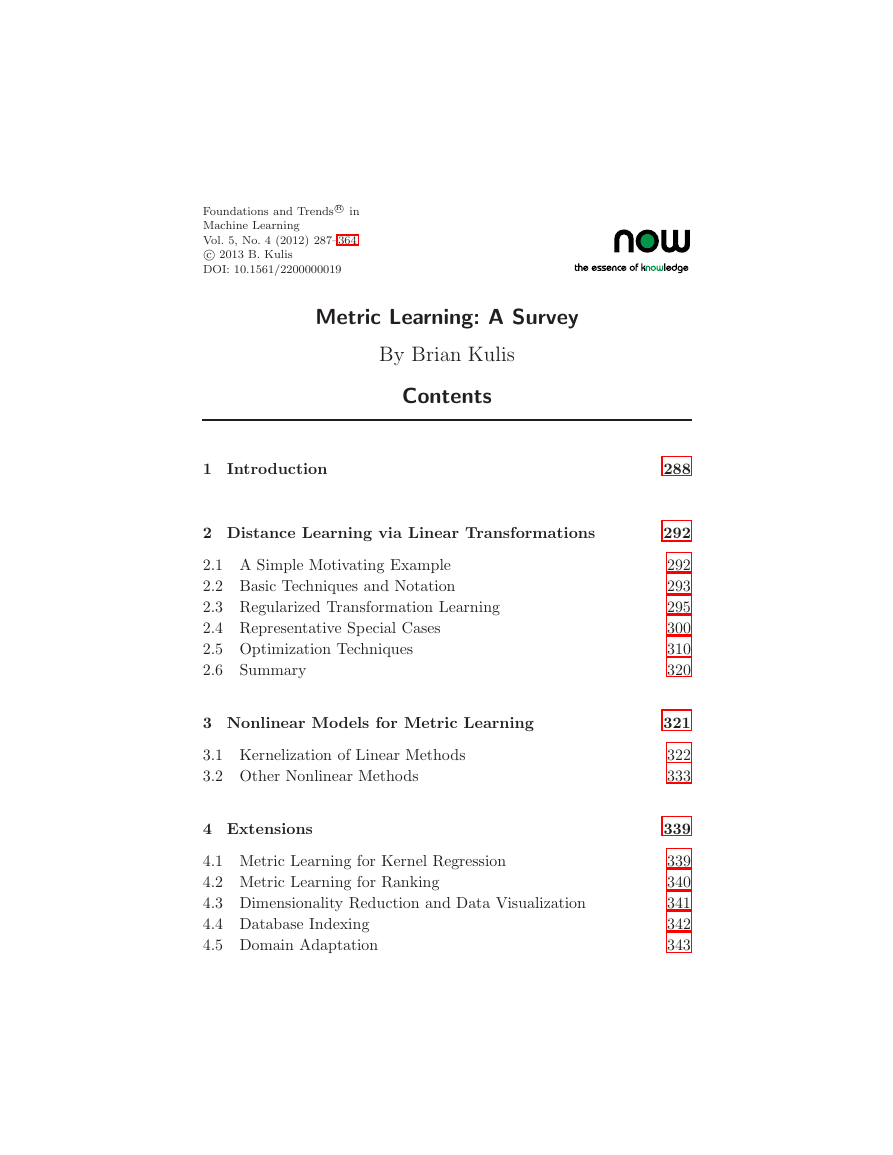
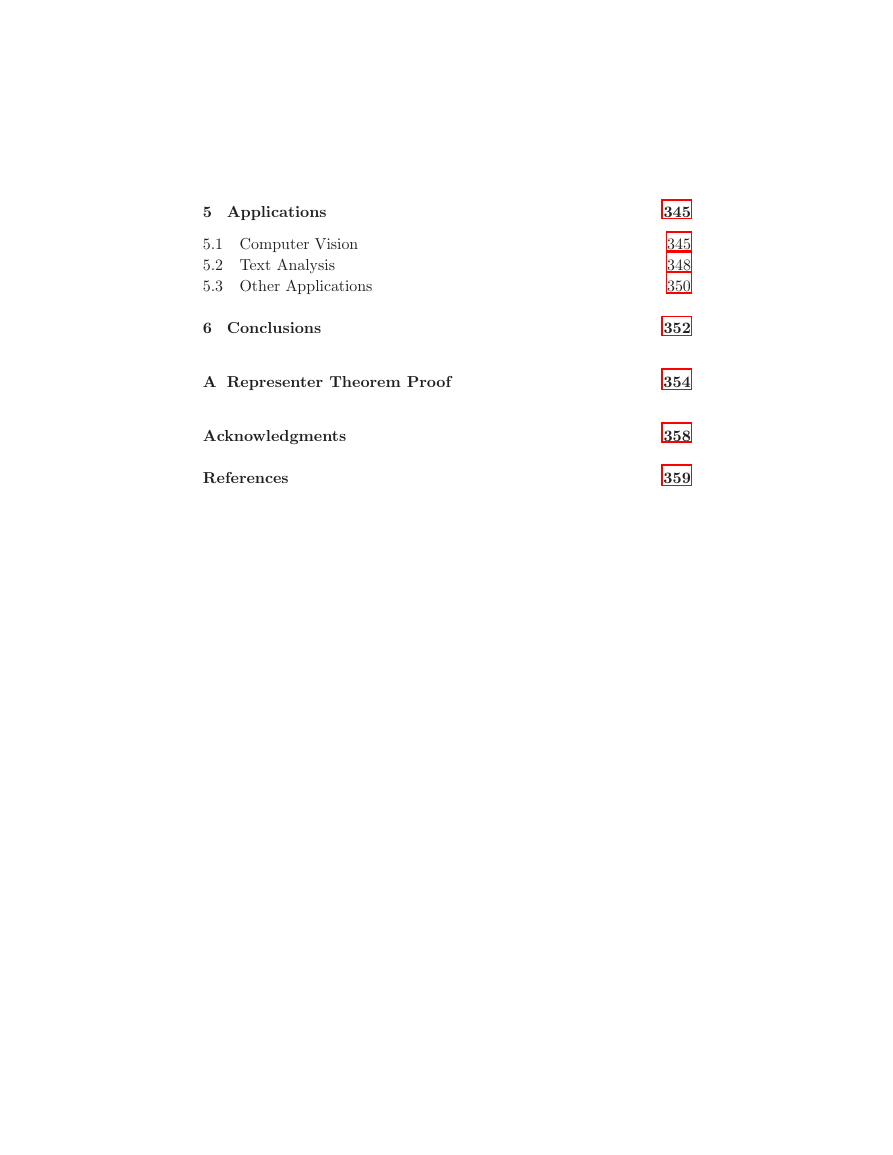
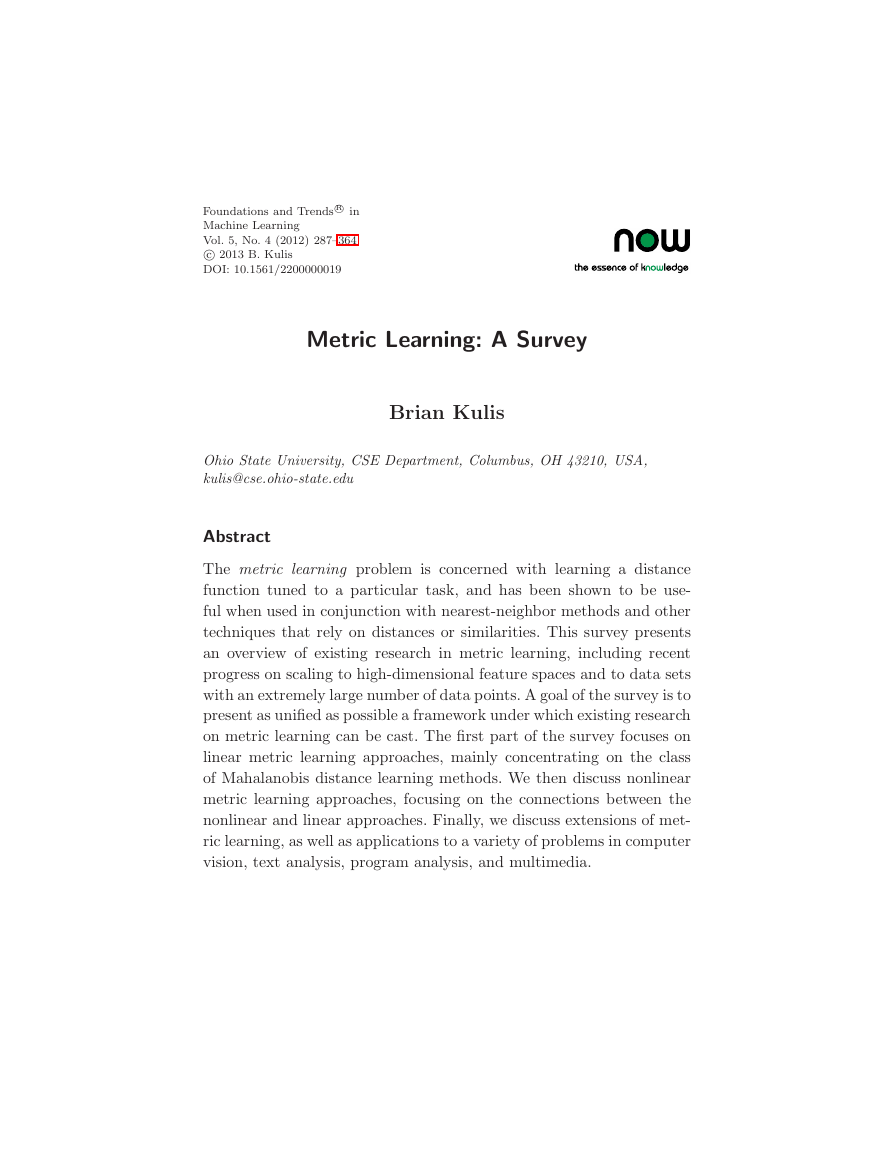
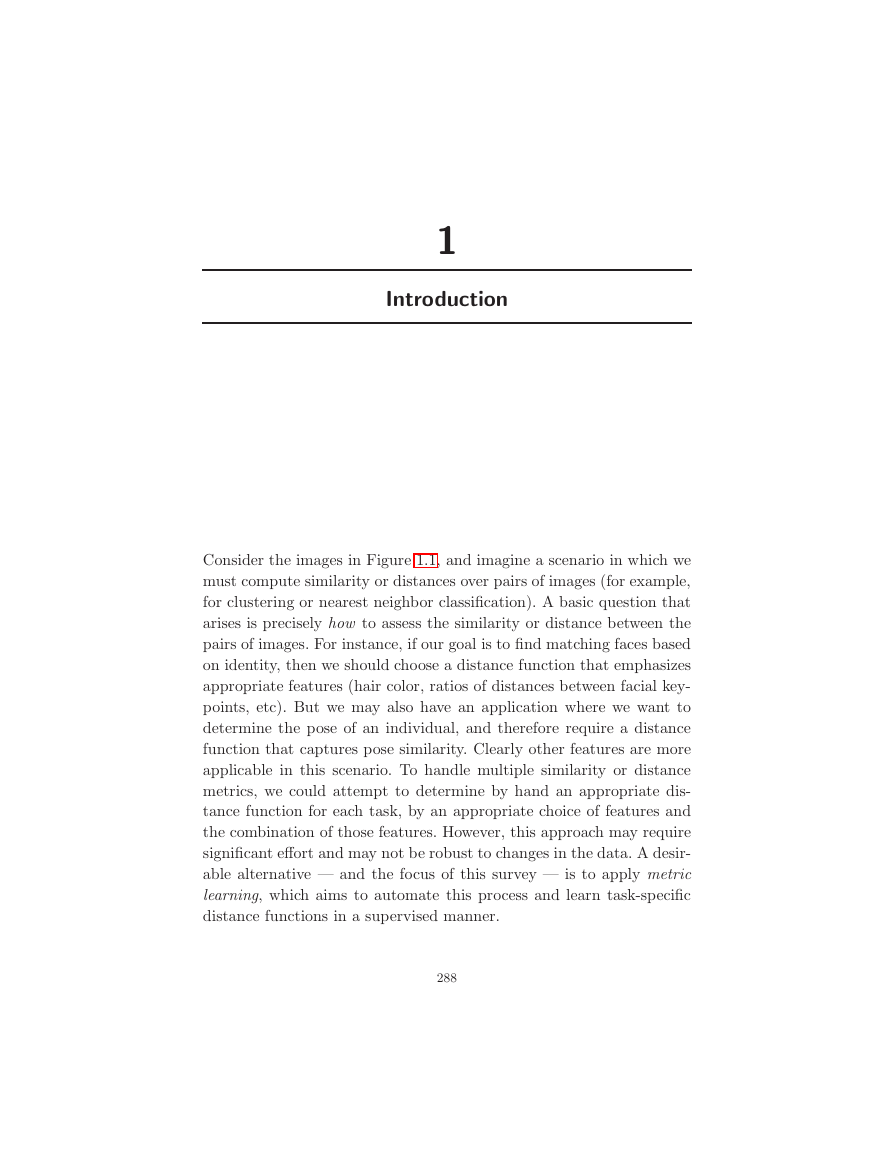
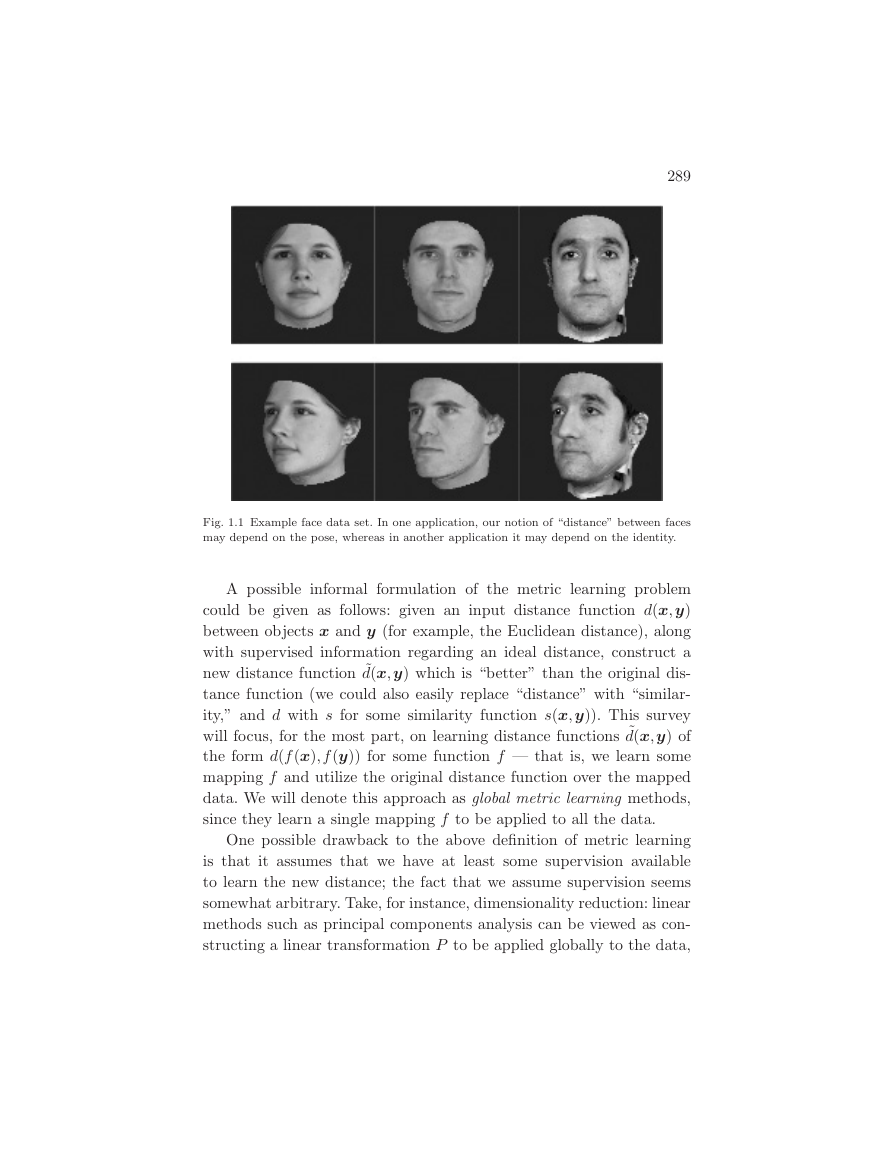
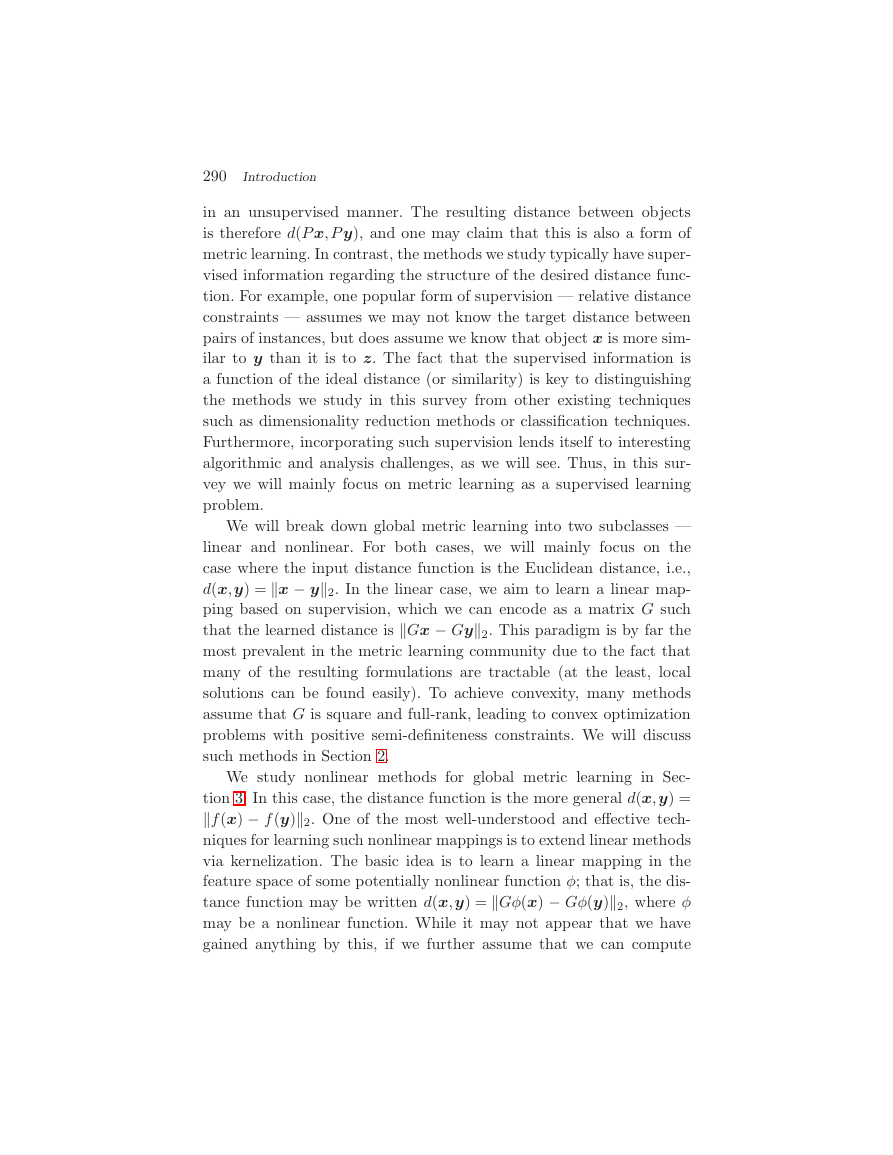
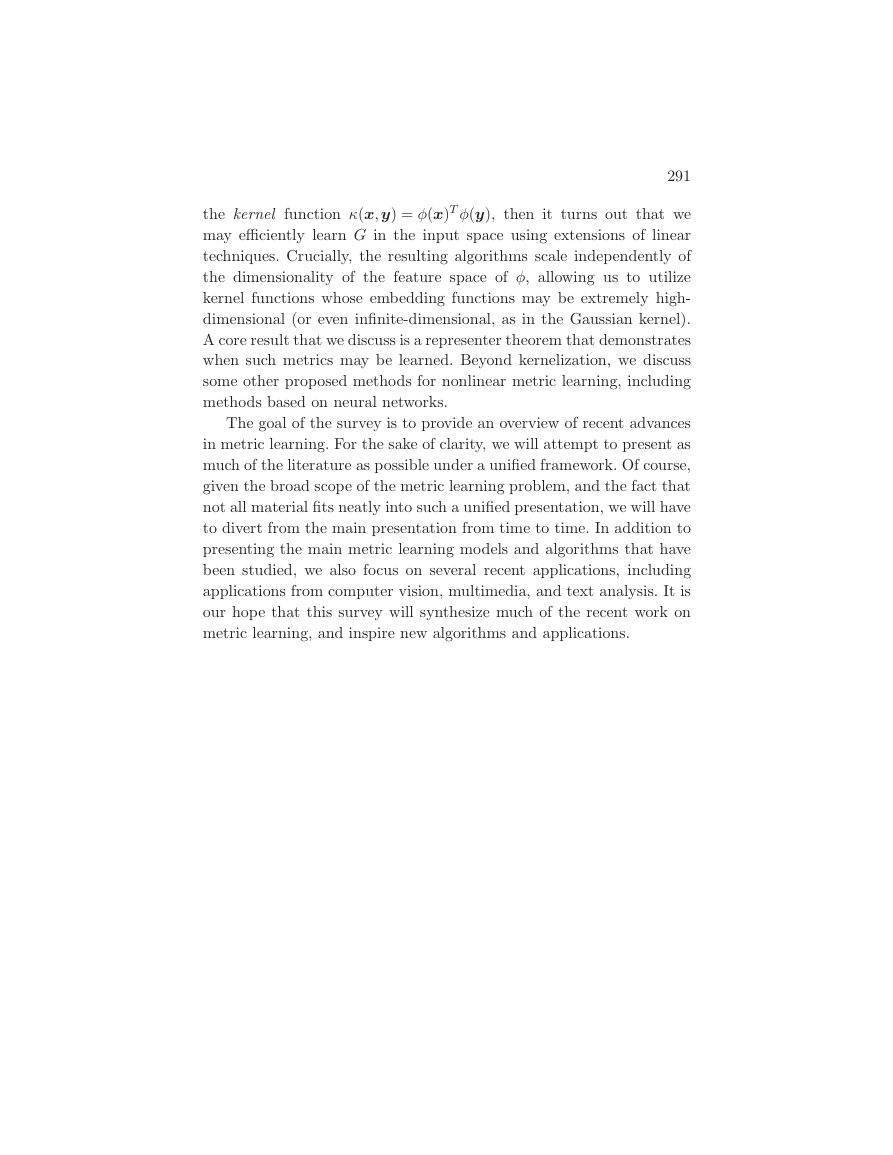









 2023年江西萍乡中考道德与法治真题及答案.doc
2023年江西萍乡中考道德与法治真题及答案.doc 2012年重庆南川中考生物真题及答案.doc
2012年重庆南川中考生物真题及答案.doc 2013年江西师范大学地理学综合及文艺理论基础考研真题.doc
2013年江西师范大学地理学综合及文艺理论基础考研真题.doc 2020年四川甘孜小升初语文真题及答案I卷.doc
2020年四川甘孜小升初语文真题及答案I卷.doc 2020年注册岩土工程师专业基础考试真题及答案.doc
2020年注册岩土工程师专业基础考试真题及答案.doc 2023-2024学年福建省厦门市九年级上学期数学月考试题及答案.doc
2023-2024学年福建省厦门市九年级上学期数学月考试题及答案.doc 2021-2022学年辽宁省沈阳市大东区九年级上学期语文期末试题及答案.doc
2021-2022学年辽宁省沈阳市大东区九年级上学期语文期末试题及答案.doc 2022-2023学年北京东城区初三第一学期物理期末试卷及答案.doc
2022-2023学年北京东城区初三第一学期物理期末试卷及答案.doc 2018上半年江西教师资格初中地理学科知识与教学能力真题及答案.doc
2018上半年江西教师资格初中地理学科知识与教学能力真题及答案.doc 2012年河北国家公务员申论考试真题及答案-省级.doc
2012年河北国家公务员申论考试真题及答案-省级.doc 2020-2021学年江苏省扬州市江都区邵樊片九年级上学期数学第一次质量检测试题及答案.doc
2020-2021学年江苏省扬州市江都区邵樊片九年级上学期数学第一次质量检测试题及答案.doc 2022下半年黑龙江教师资格证中学综合素质真题及答案.doc
2022下半年黑龙江教师资格证中学综合素质真题及答案.doc